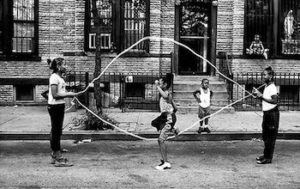
This date's Registry celebrates an outline of Double Dutch. Evolving from Africa, Double Dutch is historically a jump rope game played originally by Black children (mainly girls) in rural and urban areas in America.
The first concrete evidence of jump rope activity can be seen in medieval paintings where children roll hoops and jump rope down the cobblestone streets of Europe. Although the exact origin of jump rope activity is unclear, early explorers observed that aborigines jumped with flexible bamboo and vines during their expeditions as a form of play.
Jump rope activity can be traced back to 1600 A.D. when the Egyptians used vines for jumping. At one time, rope skipping was thought of only as a game for little girls who chanted rhymes while jumping. From the boys' perspective, it has traditionally been seen as a girl's game.
After World War II, Double Dutch was found on the sidewalks of New York City, where mothers and neighbors could safely supervise children. The girls used clothesline rope. By the late 1950s, several municipal and societal factors had made the game nearly extinct. Never extinguished, Double Dutch has been back on the streets and has moved into international competition in the last quarter-century. Players jump over a rope.
If children play alone, they take one end of the rope in each hand and swing it over and under their body, jumping when it passes beneath the feet. With at least three children, the game goes a little differently. Two children hold the ends of the rope and turn it while the third child jumps over the middle. The rope turners should be far enough apart that the rope goes over the jumper's head but barely touches the ground as it goes under the feet. If more than three people are playing, the jumper loses her turn if she catches the rope in her feet or clears the rope a set number of times. If the rope is still turning when her turn is up, she jumps out, and the next player jumps in.
Experienced jumpers can make the game more challenging by hopping on one foot, bouncing a ball, picking up and putting down a stone in between jumps, or jumping high enough for the rope to pass twice before they land. They can also add styles and tricks such as pop-ups, mambos, and worldwide. Beyond the fun and play, Double Dutch is excellent exercise.
The African American Atlas
Black History & Culture an Illustrated Reference
by Molefi K. Asante and Mark T. Mattson
Macmillan USA, Simon & Schuster, New York
ISBN 0-02-864984-2